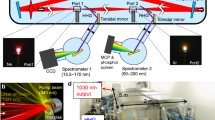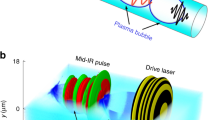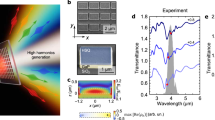Abstract
High-harmonic generation by focusing a femtosecond laser onto a gas is a well-known method of producing coherent extreme-ultraviolet (EUV) light1,2,3. This nonlinear conversion process requires high pulse intensities, greater than 1013 W cm-2, which are not directly attainable using only the output power of a femtosecond oscillator. Chirped-pulse amplification enables the pulse intensity to exceed this threshold by incorporating several regenerative and/or multi-pass amplifier cavities in tandem4,5. Intracavity pulse amplification (designed not to reduce the pulse repetition rate) also requires a long cavity6,7. Here we demonstrate a method of high-harmonic generation that requires no extra cavities. This is achieved by exploiting the local field enhancement induced by resonant plasmons within a metallic nanostructure consisting of bow-tie-shaped gold elements on a sapphire substrate. In our experiment, the output beam emitted from a modest femtosecond oscillator (100-kW peak power, 1.3-nJ pulse energy and 10-fs pulse duration) is directly focused onto the nanostructure with a pulse intensity of only 1011 W cm-2. The enhancement factor exceeds 20 dB, which is sufficient to produce EUV wavelengths down to 47 nm by injection with an argon gas jet. The method could form the basis for constructing laptop-sized EUV light sources for advanced lithography and high-resolution imaging applications.
This is a preview of subscription content, access via your institution
Access options
Subscribe to this journal
Receive 51 print issues and online access
$199.00 per year
only $3.90 per issue
Buy this article
- Purchase on Springer Link
- Instant access to full article PDF
Prices may be subject to local taxes which are calculated during checkout




Similar content being viewed by others

References
Corkum, P. B. Plasma perspective on strong-field multiphoton ionization. Phys. Rev. Lett. 71, 1994–1997 (1993)
Lewenstein, M., Balcou, P., Ivanov, M., Yu, L’Huillier, A. & Corkum, P. B. Theory of high-harmonic generation by low-frequency laser fields. Phys. Rev. A. 49, 2117–2132 (1994)
Chang, Z., Rundquist, A., Wang, H., Murnane, M. M. & Kapteyn, H. C. Generation of coherent soft X rays at 2.7 nm using high harmonics. Phys. Rev. Lett. 79, 2967–2970 (1997)
Strickland, D. & Mourou, G. Compression of amplified chirped optical pulses. Opt. Commun. 56, 219–221 (1985)
Seres, J. et al. Laser technology: Source of coherent kiloelectronvolt X-rays. Nature 433, 596 (2005)
Gohle, C. et al. A frequency comb in the extreme ultraviolet. Nature 436, 234–237 (2005)
Jones, R. J., Moll, K. D., Thorpe, M. J. & Ye, J. Phase-coherent frequency combs in the vacuum ultraviolet via high-harmonic generation inside a femtosecond enhancement cavity. Phys. Rev. Lett. 94, 193201 (2005)
Nisoli, M. Nanoplasmonics: Brave new attoworld. Nature Photon. 1, 499–500 (2007)
Roth, M. R., Panoiu, C. N., Adams, M. M. & Osgood, M. R. Resonant-plasmon field enhancement from asymmetrically illuminated conical metallic-probe tips. Opt. Express 14, 2921–2931 (2006)
Schatz, G. C. & Van Duyne, R. P. Handbook of Vibrational Spectroscopy Vol. 1 (eds Chalmers, J. M & Griffiths, P. R.) 759–774 (Wiley, Chichester, 2002)
Bohn, L. J., Nesbitt, J. D. & Gallagher, A. Field enhancement in apertureless near-field scanning optical microscopy. J. Opt. Soc. Am. A 18, 2998–3006 (2001)
Mühlschlegel, P., Eisler, H.-J., Martin, O. J. F., Hecht, B. & Pohl, D. W. Resonant optical antennas. Science 308, 1607–1609 (2005)
Bragas, A. V. & Martínez, O. E. Field-enhanced scanning optical microscope. Opt. Lett. 25, 631–633 (2000)
Stockman, M. I. Nanofocusing of optical energy in tapered plasmonic waveguides. Phys. Rev. Lett. 93, 137404 (2004)
Lesuffleur, A., Kumar, L. K. S. & Gordon, R. Enhanced second harmonic generation from nanoscale double-hole arrays in a gold film. Appl. Phys. Lett. 88, 261104 (2006)
Jin, E. X. & Xu, X. Enhanced optical near field from a bowtie aperture. Appl. Phys. Lett. 88, 153110 (2006)
Onuta, T.-D., Waegele, M., DuFort, C. C., Schaich, W. L. & Dragnea, B. Optical field enhancement at cusps between adjacent nanoapertures. Nano Lett. 7, 557–564 (2007)
Sun, W.-X. & Shen, Z.-X. Optimizing the near field around silver tips. J. Opt. Soc. Am. A 20, 2254–2259 (2003)
Tzeng, Y.-F. et al. Fabrication of an ultra-nanocrystalline diamond-coated silicon wire array with enhanced field-emission performance. Nanotechnology 18, 435703 (2007)
Fromm, D. P., Sundaramurthy, A., James Schuck, P., Kino, G. & Moerner, W. E. Gap-dependent optical coupling of single “bowtie” nanoantennas resonant in the visible. Nano Lett. 4, 957–961 (2004)
Krug, J. T., Sánchez, E. J. & Xie, X. S. Design of near-field optical probes with optimal field enhancement by finite difference time domain electromagnetic simulation. J. Chem. Phys. 116, 10895–10901 (2002)
Gai, H., Wang, J. & Tian, Q. Modified Debye model parameters of metals applicable for broadband calculations. Appl. Opt. 46, 2229–2233 (2007)
Zhou, J., Peatross, J., Murnane, M. M., Kapteyn, H. C. & Christov, I. P. Enhanced high-harmonic generation using 25 fs laser pulses. Phys. Rev. Lett. 76, 752–755 (1996)
Wahlström, C.-G. et al. High-order harmonic generation in rare gases with an intense short pulse laser. Phys. Rev. A 48, 4709–4720 (1993)
Wang, X. C. et al. Femtosecond pulse laser ablation of sapphire in ambient air. Appl. Surf. Sci. 228, 221–226 (2004)
Güdde, J., Hohlfeld, J., Müller, J. G. & Matthias, E. Damage threshold dependence on electron-phonon coupling in Au and Ni films. Appl. Surf. Sci. 127–129, 40–45 (1998)
Acknowledgements
This work was supported by the Creative Research Initiatives Program of the Ministry of Science and Technology in the Republic of Korea.
Author information
Authors and Affiliations
Corresponding author
Rights and permissions
About this article
Cite this article
Kim, S., Jin, J., Kim, YJ. et al. High-harmonic generation by resonant plasmon field enhancement. Nature 453, 757–760 (2008). https://doi.org/10.1038/nature07012
Received:
Accepted:
Issue Date:
DOI: https://doi.org/10.1038/nature07012
This article is cited by
-
Efficiently accelerated free electrons by metallic laser accelerator
Nature Communications (2023)
-
Metal-organic framework template-guided electrochemical lithography on substrates for SERS sensing applications
Nature Communications (2023)
-
Highly Confined Terahertz Surface Plasmons Generation in Graphene-Coated Optical Fiber by Nonlinear Mixing of Two Laser Beams
Plasmonics (2023)
-
Quintuple Plasmonic Fano Resonances for the Sensing Application of Glucose Concentration and Water-soluble Vitamins
Plasmonics (2023)
-
Magnetron-Sputtered Silver Nanoparticles for Surface Plasmons for Terahertz Sensors
Journal of Electronic Materials (2023)
Comments
By submitting a comment you agree to abide by our Terms and Community Guidelines. If you find something abusive or that does not comply with our terms or guidelines please flag it as inappropriate.


